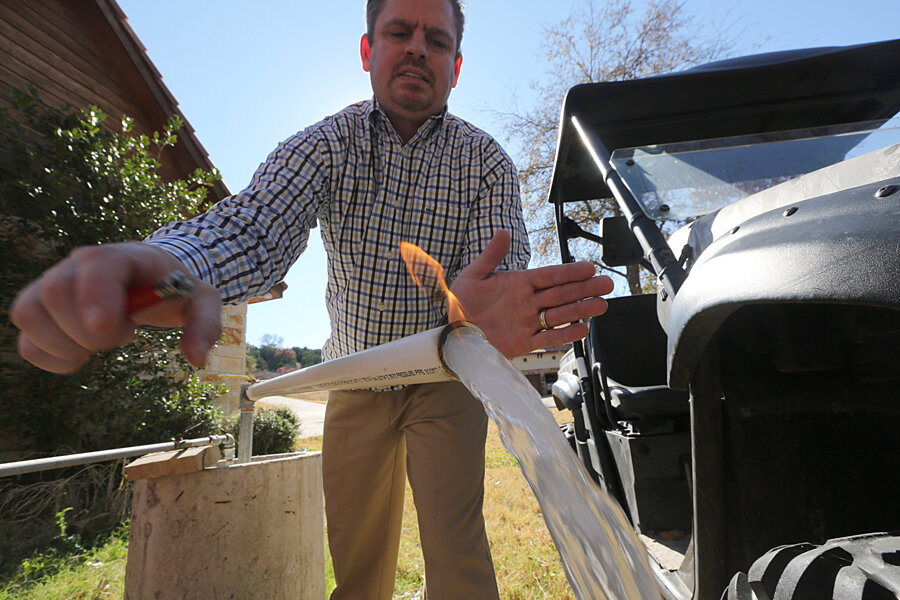EPA seen as underreporting emissions: what that means for natural gas use
For years, natural gas has enjoyed a reputation as the cleanest fossil fuel because it releases less carbon dioxide into the atmosphere when it is burned than coal or oil.
With technology that allows companies to extract gas from reservoirs trapped in underground shale deposits in the US, domestic gas has become plentiful and cheap. As a result, it is increasingly replacing coal in power generation, and is substituting for gasoline and diesel fuel in fleets of retrofitted vehicles.
But from a climate standpoint, how clean is it?
Some recent studies have suggested that the harvesting and production of natural gas – including by fracking – emits enough carbon, via methane, into the atmosphere that it may not be worth substituting it for coal.
Into this debate steps a finding by researchers that the US may be emitting from 25 percent to 75 percent more methane from all sources than is estimated in annual federal assessments of the country's emissions.
That finding, in itself, is concerning, as methane is a potent greenhouse gas, but is it a factor in the debate over natural gas? Supporters of the industry can breath easy.
The researchers, who were analyzing the federal emissions assessments with an eye for improving them, concluded that even if – for the sake of argument – the natural gas industry were responsible for all the additional methane emissions, natural gas would still have an advantage in lower carbon emissions compared with coal for industrial uses.
The analysis appears as a "Policy Forum" article in the current issue of the journal Science. It comes at a time when some studies on strategies for curbing greenhouse-gas emissions have suggested that by curbing industrial emissions of methane, as well as black-carbon soot and other relatively short-lived heating agents, the world could slow the pace at which global average temperatures have risen over the past century.
Indeed, in 2012, the US Environmental Protection Agency issued new rules for reducing air pollution from oil and gas exploration and production – including methane emissions from gas production. The regulations are to take full effect next year. When they do, by some estimates they will lower methane emissions by 1 million to 1.7 million tons a year.
The new analysis appears to be the first to take a comprehensive independent look at US methane emissions. It takes advantage of a number of recent studies that use a range of direct measurements – from remote sensing aircraft and sensors on towers to on-site checks for leaks. Methane-emission estimates from such studies tend to show that EPA records are underestimating such emissions.
Drawing on these studies, a team that includes scientists from seven universities, two national laboratories and the National Oceanic and Atmospheric Administration, as well as three non-government organizations, estimated that the country is emitting some 7 million to 21 million more tons of methane than the EPA records, with 14 million tons as the most likely number.
The team cites several reasons for the discrepancy. For instance, the EPA takes measurements at locations that agree to cooperate with the agency, which can skew its estimates. And for purely budgetary reasons, there’s a limit on the number of sites the agency can sample regularly.
The team also tried to estimate what portion of the EPA’s emissions estimates were from the natural gas operations industry, in no small part to test the conclusions from a small handful of studies asserting that when these emissions are taken into account, natural gas loses its advantage over coal in reducing CO2 emissions.
"The exact contribution of natural gas to this overall excess is unknown at this point; there's not enough scientific evidence to give a firm answer," said Adam Brandt, the lead author of the analysis and a Stanford University researcher who focuses on energy resource engineering.
So the team assumed the worst – that natural gas emissions make up the entire 14-million-ton-per-year EPA undercount, something they acknowledge as highly unlikely given that range of possible emissions sources.
Even if the gas industry was responsible for all the methane emissions that exceed the EPA inventory, looking at natural gas as a temporary "bridge" fuel and its effect on greenhouse gas emissions over the next 100 years, "substituting natural gas in place of coal still looks significantly beneficial."
Even at the highest estimate for methane emissions and assuming all of that came from the natural-gas industry, "which we think is unlikely," gas still beats coal, Dr. Brandt said at a briefing on the study held earlier this week.
The picture is somewhat more cloudy for transportation, where cities are converting bus fleets and some corporations and state government are converting cars to run on natural gas.
The team found that over the same 100-year span, it was unclear if there was a benefit to the climate from using natural gas instead of gasoline for cars and light trucks. When applied to heavy vehicles, such as buses, natural gas appeared unlikey to be any more beneficial than diesel fuel – although the researchers acknowledge that the shift from diesel to natural gas also is occurring for general air-quality reasons.





